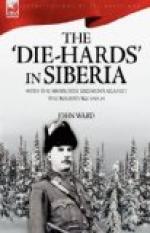Over this featureless wilderness we progressed day after day, each stopping-place marked by a few aspen trees mixed up with a few others that look very much like mountain ash but are not. The winter houses of the people are single-roomed, square, wooden structures, very strangely built, with flat roofs consisting of about two feet of earth. Against and over these structures in winter the frozen snow piles itself until they have the appearance of mere mounds, impossible to locate except for the smoke which escapes from a few long crevices left open under the eaves of what is intended to be the front of the house. These smoke-escapes perform the double duty of chimneys and also keep clear the way by which the inhabitants go in and out. Their herds are either disposed of before the winter begins or are housed in grass-covered dug-outs, which in winter, when the snow is piled over them, take the form of immense underground caverns, and are quite warm and habitable by both man and beast. The one I entered had over two hundred beautiful little foals housed in it, and others similar in character had cows and sheep and poultry all as snug as you please. The entrance was lighted with a quaint old shepherd’s lantern, not unlike those I had seen used by shepherds in Hampshire when I was a boy. The entrance was guarded all night by a number of dogs, and curled up in a special nook was the herdsman, with a gun of a kind long since discarded in Europe. Such are the conditions under which these people live half the year, but they make up for this underground life when in April they start their cattle on the move by first allowing them to eat their shelters.




